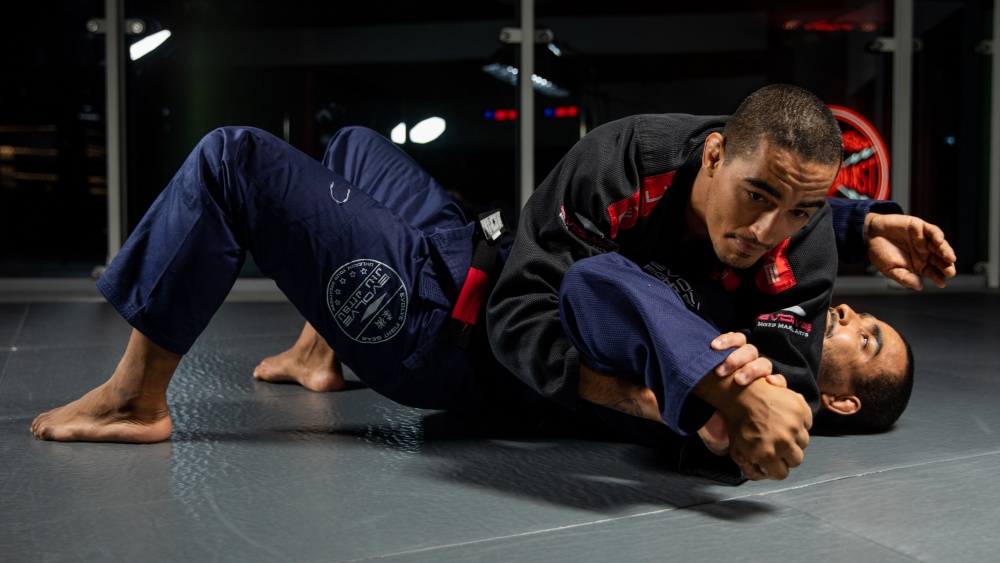The Americana, also known as the key-lock in wrestling, and ude garami in Judo is a shoulder lock in Brazilian Jiu-Jitsu that applies pressure on the shoulder of the opponent by bending the arm at a 90-degree angle. Today, we will talk about the Americana and other submissions that you may transition to by doing it.
The Americana
Normally known as a big man move in Jiu-Jitsu together with the kimura, the Americana is one of the basic submissions in Jiu-Jitsu and is effective when performed with proper weight distribution and leverage.
The Americana is said to be developed by catch wrestlers and judokas as a form of figure-four armlock similar to the kimura. It was theoretically spread in Brazil by judokas and professional wrestlers during their pro wrestling tours. Even though the time when the Americana was first popularized in competitions is unspecified, it is known to be around in Jiu-Jitsu in the early 1960s.
Similar to the motion of turning a door with a key, the Americana is typically done by grabbing the wrist of the opponent with a figure-four grip while their hand faces up the ceiling and twisting it laterally. The twisting motion creates uncomfortable pressure to the shoulder and elbow joint.
The key to a powerful Americana is proper weight distribution and leverage. This prevents the opponent from rolling you over, especially when attempting this submission to a bigger and heavier opponent.
How To Perform The Americana From The Mount
To perform the Americana from the mount or in side control, you must first secure your position. It is important to always secure the position before going in for the submission, to avoid losing the positional control, and to prevent getting reversed and swept.
To do the Americana from the mount, choose an arm that you want to attack. Pin the elbow and the wrist of your opponent to the ground. Keep your elbows close to the face of your opponent as you grab his wrist with a figure-four grip. A figure-four grip is done by grabbing the wrist of your opponent, as your other hand grabs your own wrist that is gripping the wrist of the opponent.
After grabbing the hand of your opponent with a figure-four grip, start by lifting his elbow while driving his wrist down. The leverage from lifting the elbow and driving of the wrist will neutralize the flexibility of your opponent, making him unable to tolerate the shoulder pressure.
How To Perform The Americana From Side Control
The Americana from side control is the most common way to execute this submission. Start by securing the side control by using your knees to block the hips of your opponent while maintaining heavy hips. Keep the chest-to-chest pressure to pin your opponent down. The natural reaction of the opponent is to create a frame. This creates the opportunity for you to pin down his framing hand on the ground.
Pin the hand of your opponent and apply the figure-four grip. Likewise, keep the wrist of your opponent to the ground while slowly driving it down as you lift his elbow up to maximize the shoulder pressure. Using your head to pin the arm of your opponent is also a good way to finish this submission.
Americana is also known as the paintbrush. The reason for it is that it mimics the motion of painting a brush. Think of the hand of the opponent as the bristles of the brush connecting to the mat as you lift his elbows up to do a brushing motion. The paintbrush can also be done from the mount, although some practitioners may prefer to do it from the side control, as it is more efficient and makes the transition to other submissions easier. Aside from being a submission itself, the Americana can also be used to set up other submissions.
Chaining the Americana with Other Submissions
As you get to face more experienced opponents, sometimes finishing the Americana may be a little tricky. It is important to anticipate the defensive reaction that your opponent may do once you go for the Americana, as it can also be used as an initial threat to set up other submissions. Below are the submissions that you may try to perform if your attempt to finish the Americana fails.
1) Americana to Armbar
An Americana done from the mount may, at times, cause the opponent to react by turning his body and pulling his arms to the opposite side. This opens the window for the armbar. As soon as the opponent turns his body and his arms, you can pivot right in to execute the armbar. Initially, you may want to maintain the Americana grip, but as soon as you shoot for the armbar, it is ideal to switch grips to finish successfully.
2) Americana to Straight Armlock
In instances, it may be difficult to finish the Americana when the opponent is powerful enough to straighten his arm. When this happens, the straight armlock is a good way to transition from the Americana.
The straight armlock from the mount can be done if your opponent decides to straighten his arm as a defensive reaction from the Americana. Just as when the opponent stretches his arm, start by tightening the Americana grip to make sure his hand is pointing upwards (thumbs-up). When doing the straight armlock, you may lean your head towards the opponent’s arm to add more weight and to make sure the pressure on the elbow is adequate. Just be mindful as there is the possibility of getting reversed.
Another way to attack with the Americana is by the use of the legs. We normally see the success of Americana from the side or mounted position, but it can also be finished when you are in the bottom side control, just like what is shown in the video.
Final Thoughts
The Americana may be considered as a big man move, but it can be practiced and finished by anyone with proper leverage and weight distribution. Just like any submission in Jiu-Jitsu, honing your skills takes time. Constantly drilling the Americana trap and chaining it with other submissions can be fun, as the Americana can be applied in almost any position. Plus, it can also be done with the use of the legs, which work wonders.
You may also like:
















